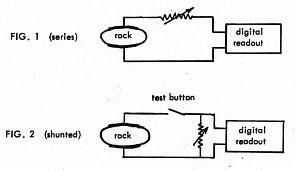Test No. 108 - "Koolau Basalt Load Tests"
(Part 1)
(Return to Index Page)
June 13, 1977
Stewart Ct. Laboratory
Sunnyvale, CA
Copyrighted © by The Townsend Brown family. All rights reserved.


 PURPOSE
PURPOSE:
To observe the effect of adding increasing resistive load to the
petroelectric output of the specimen of Koolau basalt (from the extinct
Koolau Volcano, Island of Oahu, Hawaii).
 PROCEDURE
PROCEDURE:
The rock was loaded in two ways as follows:
 RESULTS
RESULTS:
In Fig. 1, the rock was not shorted (zero resistance) at any
time. Prolonged shorting depolarizes and temporarily inactivates the rock.
The total input resistance of the readout system (1 megohm) represented the
maximum load. The curve indicates the reduction in current as the series
resistance increases from 1 megohm up to 1000 megohms (1G).
In Fig. 2, the rock output was directly shunted by the applied
resistive load. Each reading was made within approx. 5 seconds, using a test
button, so that gradual depolarization would not have time to take place.
The momentary drain did not seriously affect the capacitive reserve within
the rock. After each reading, even with a dead short for only 5 seconds,
the self-potential of the rock recovered fully.
 CONCLUSIONS
CONCLUSIONS:
This test appears to point out the rather surprising capacitance
of the Koolau rock (approximate dimensions 5" x 6" x 15"). The ability to
withstand the continuing series of load tests (10 minutes apart), ending in
a dead short and to recover the original emf virtually completely is
certainly unusual for capacitors. This behavior is more like that found in
batteries, where the continuous renewal by conversion of chemical energy.
The phenomenon apparent here indicates a continuing energy replacement.

Graphic -
Figure 3


 Please be advised that this document is copyrighted © by The Townsend Brown family. All rights reserved.
Please see Legal and Copyright Information for additional copyright information.
Please be advised that this document is copyrighted © by The Townsend Brown family. All rights reserved.
Please see Legal and Copyright Information for additional copyright information.


 Graphic -
Figure 3
Graphic -
Figure 3



 Graphic -
Figure 3
Graphic -
Figure 3
